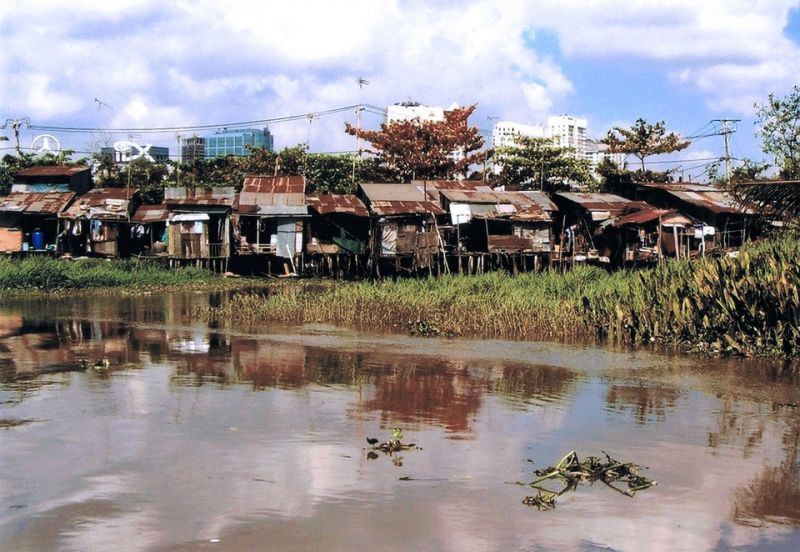Testing a New Water Security Approach for Urban Slums
Published on by Carlos Santamaria in Social
The sight of children playing is usually a universal reason to smile. But today that image feels very different – the children I see down the muddy road are playing in a highly contaminated environment.
By Tony Wong CEO, Cooperative Research Centre for Water Sensitive Cities*
They are barefoot and cheeky grins galore, but in truth, these children are an acute reminder of the conditions many face everyday in the world’s urban slums.

Better sanitation services are clearly an urgent need in Asia’s urban slums.
In the race for development, people living in informal settlements—polluted places with a pervasive lack of clean water—are often (ironically) left behind. They remain without the most basic of urban water services: water supply, sanitation, drainage, and flood protection.
I am reminded of the pledge made by member states signing up to the UN Sustainable Development Goals to “leave no one behind,” and to “reach first those who are furthest behind.”
In urban slums, one of the foremost health threats for inhabitants is the fact that their water (for drinking, washing, and recreation) and their living environments are very often contaminated with fecal waste, both human and animal. The problem is insidious. It stems from waste produced within the settlement (via open defecation or when rudimentary latrine systems overflow), which can seep into groundwater; and it can also occur when floodwater carries contamination from upstream sources.
The impact of such conditions is devastating. Diarrhea alone causes the death of 1,500 children every day, Gastrointestinal diseases are rampant, stunting growth in young children and leading to lasting effects that reinforce the poverty cycle.
Better sanitation services are clearly an urgent need.
The typical development response is to wait for traditional, slow-to-implement trunk infrastructure (big pipes in the ground) to reach these communities. In the interim, toilets may be provided that connect to cesspits or septic tanks, or directly (and without treatment) into the surrounding waterways.
These interim solutions, however, often fail because the waste generated is too much for the local environment to handle. More conventional sewerage infrastructure can hardly keep pace with the increasing spread of urbanization, so informal settlements must endure high health risks for years. For many families, it takes two to three generations before change arrives.
Transforming informal settlements
There must be an alternative, expeditious way to mitigate health implications and meet other urgent development needs, too.
The Cooperative Research Centre for Water Sensitive Cities (CRCWSC) is working with ADB to apply new research in areas like water supply, sanitation, and flood management to help cities in Asia and the Pacific become more sustainable and resilient. The partnership is under ADB’s Future Cities technical assistance.
We realized that water security and urban places are intimately connected. Water for drinking, waterways used for bathing and recreation, flood mitigation, and sewage management are not isolated things. Integrated water management is a lever for guiding urban design, merging energy, water, environmental, and social needs to create healthy, livable cities.
The goal is to harness these benefits, underpinned by strong evidence, to transform informal settlements.
Along with ADB and the UK-based Wellcome Trust, a Monash University-led team including CRCWSC is working towards trialing a water-sensitive approach to revitalize informal settlements and their environments.
Together we aim to introduce green urban design and technologies that enable communities to safely recycle wastewater, harvest rainwater and stormwater, and protect themselves against flooding and pollution. Applied at the different scales that make up the whole urban picture (households, neighborhoods, and whole precincts), this approach enables outcomes that go beyond simply providing clean water and sanitation services.
Our proposed solution closes the water cycle loop to make local waterways healthier, and water supplies more secure. It reduces flood vulnerability, creates landscapes for growing high-value crops, and delivers a viable receiving environment for effluent from wetlands constructed for wastewater treatment.

Image source: Max Pixel
Read full blog: Asia Development Blog
Media
Taxonomy
- Water
- Decentralized Wastewater
- Water Rights
- Water Security
- Wastewater Treatment
- Sanitation
- Water Resources
- Sustainable Sanitation
- Water Security
- Water & Sanitation
- Water Security
- Sanitation & Hygiene
- Sanitation & Hygiene
- Water
- Sanitation and Hygiene
- Water Sanitation & Hygiene (WASH)
- urban water security
1 Comment
-
there is further information regarding this solution in the web? I live in Rio de Janeiro, Brazil and we face this problem in all the slums, some of them with more than 100.000 people